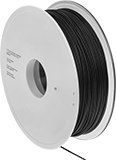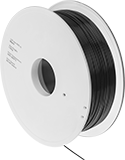Easy-to-Print PLA 3D Printer Filaments

The most commonly used 3D printing material, these PLA filaments make detailed parts at a low melting point, so they won’t warp as they cool, rarely clog nozzles, and don’t require a heated printer bed. They’re also unlikely to drip and produce plastic strings for a clean finished part. In general, they’re best for printing prototypes instead of load-bearing parts since they’re not as strong as ABS or as heat resistant as PEEK. Print them on a fused filament fabrication (FFF) 3D printer.
Static-dissipative PLA filaments make parts that protect equipment from electrostatic shocks by diverting electrostatic discharges in a controlled way. They’re often used to create tool handles, tote trays, enclosures, and other parts that are used near sensitive electronics. To adjust the surface resistivity of your printed part, change the temperature of your printer’s extruder. As the extruder’s temperature increases, the printed part’s resistivity will decrease.
Tensile strength is the best measure of a filament’s overall strength. Similar to the stress applied on a rope during a game of tug-of-war, it’s the amount of pulling force a material can handle before breaking. A higher rating means a stronger filament. A tensile strength of 5,000 psi and above is considered good; 12,000 psi and above is excellent.
Maximum exposure temperature is the point at which a printed part will begin to deform. Above this temperature, your part will start to lose structural integrity.
Spool | ||||||||||
|---|---|---|---|---|---|---|---|---|---|---|
| Dia., mm | Printing Temp. | For Printer Bed Temp. | Tensile Strength | Max. Exposure Temp. | For Min. Nozzle Dia., mm | Dia., mm | Dp., mm | Wt., g | Each | |
Static-Dissipative PLA Plastic | ||||||||||
Opaque Black | ||||||||||
| 1.75 | 210° to 220° C 410° to 430° F | 23° to 60° C 73° to 140° F | 7,970 psi (Good) | 55° C 131° F | 0.25 | 200 | 70 | 750 | 0000000 | 0000000 |
| 2.85 | 210° to 220° C 410° to 430° F | 23° to 60° C 73° to 140° F | 7,970 psi (Good) | 55° C 131° F | 0.25 | 200 | 70 | 750 | 0000000 | 000000 |
Impact-Resistant ABS 3D Printer Filaments

Bumps, scrapes, and falls won’t damage these tough ABS filaments. Known for their durability, they absorb impact without cracking or breaking, and won’t degrade when heated. Use them to print tool handles, storage cases, and other parts that are handled or dropped frequently. These filaments are a good place to start if you’re experimenting with printing impact-resistant parts.
Use with a fused filament fabrication (FFF) 3D printer. These filaments have a high melting point and must be printed onto a heated bed. Without it, parts will cool too quickly and warp. These filaments also release fumes as they are printed, so use an enclosed printer or a fume exhauster to ventilate them.
Static-dissipative filaments make parts that protect equipment from electrostatic shocks by diverting electrostatic discharges in a controlled way. Use them to create tool handles, tote trays, enclosures, and other parts that are used near sensitive electronics. To adjust the surface resistivity of your printed part, change the temperature of your printer’s extruder. As the extruder’s temperature increases, the printed part’s resistivity will decrease.
Tensile strength is the best measure of a filament's overall strength. Similar to the stress applied on a rope during a game of tug-of-war, it's the amount of pulling force a material can handle before breaking. A higher rating means a stronger filament. A tensile strength of 5,000 psi and above is considered good; 12,000 psi and above is excellent.
Maximum exposure temperature is the point at which a printed part will begin to deform. Above this temperature, your printed parts will start to lose structural integrity.
Spool | ||||||||||||
|---|---|---|---|---|---|---|---|---|---|---|---|---|
| Dia., mm | Printing Temp. | For Printer Bed Temp. | Tensile Strength | Surface Resistivity, ohms/sq. | Max. Exposure Temp. | For Min. Nozzle Dia., mm | Dia., mm | Dp., mm | Wt., g | Color | Each | |
ABS Plastic—Static-Dissipative | ||||||||||||
| 1.75 | 220° to 240° C 428° to 464° F | 100° to 110° C 212° to 230° F | 8,410 psi (Good) | 107-109 | 97° C 207° F | 0.4 | 200 | 75 | 750 | Black | 0000000 | 0000000 |
| 2.85 | 220° to 240° C 428° to 464° F | 100° to 110° C 212° to 230° F | 8,410 psi (Good) | 107-109 | 97° C 207° F | 0.4 | 200 | 75 | 750 | Black | 0000000 | 000000 |
High-Strength Impact-Resistant Polycarbonate 3D Printer Filaments

Create strong, durable parts that carry heavy loads and absorb blows and other impact without cracking or breaking. Made of polycarbonate, these filaments are stronger and resist heat better than other impact-resistant filaments, such as those made from ABS or ASA.
Use with a fused filament fabrication (FFF) 3D printer. These filaments have a high melting point and must be printed onto a heated bed. Without it, parts will cool too quickly and warp. These filaments also release fumes as they are printed, so use an enclosed printer or a fume exhauster to ventilate them.
Static-dissipative filaments make parts that protect equipment from electrostatic shocks by diverting electrostatic discharges in a controlled way. Use them to create tool handles, tote trays, enclosures, and other parts that are used near sensitive electronics. To adjust the surface resistivity of your printed part, change the temperature of your printer’s extruder. As the extruder’s temperature increases, the printed part’s resistivity will decrease.
Tensile strength is the best measure of a filament's overall strength. Similar to the stress applied on a rope during a game of tug-of-war, it's the amount of pulling force a material can handle before breaking. A higher rating means a stronger filament. A tensile strength of 5,000 psi and above is considered good; 12,000 psi and above is excellent.
Maximum exposure temperature is the point at which a printed part will begin to deform. Above this temperature, your printed parts will start to lose structural integrity.
Spool | |||||||||||||
|---|---|---|---|---|---|---|---|---|---|---|---|---|---|
| Dia., mm | Printing Temp. | For Printer Bed Temp. | Tensile Strength | Surface Resistivity, ohms/sq. | Hardness | Max. Exposure Temp. | For Min. Nozzle Opening Dia., mm | Dia., mm | Dp., mm | Wt., g | Color | Each | |
Polycarbonate Plastic—Static-Dissipative | |||||||||||||
| 1.75 | 260° to 300° C 500° to 572° F | 110° to 120° C 230° to 248° F | 9,860 psi (Good) | 107-109 | Rockwell R125 (Hard) | 135° C 275° F | 0.4 | 200 | 75 | 750 | Black | 0000000 | 0000000 |
Moisture-Resistant Polyester 3D Printer Filaments

Parts printed with these polyester filaments absorb less moisture than other types of plastic, making them ideal for use in wet or humid environments. They are more durable and flexible than PLA, and easier to print than ABS. Use these filaments with fused filament fabrication (FFF) 3D printers, and print onto a heated print bed. Printing onto a cool surface causes the molten filament to change temperature rapidly, which can warp your designs. Although finished parts are moisture-resistant, these filaments are sensitive to humidity, and should be stored in a dehumidifying cabinet or a sealed container with desiccant for the best printing quality.
PETT forms strong bonds between layers, so prints will not split apart. It is often used to make large models with large layers.
PETG contains glycol, so it is less brittle and easier to print than PETT and PCTG. Carbon-fiber-filled PETG is often used to make rigid parts that are difficult to bend and break. Finished parts are easier to thread and machine than unfilled parts. Because these filaments are abrasive, use them only with abrasion-resistant nozzles.
PCTG is more impact resistant than PETT and PETG and holds up to a wide range of acids and bases without breaking down. It is often used for printing parts that will be exposed to chemicals and oils.
Static-dissipative filaments make parts that protect equipment from electrostatic shocks by diverting electrostatic discharges in a controlled way. Create tool handles, tote trays, enclosures, and other parts that are used near sensitive electronics. To adjust the surface resistivity of your printed part, change the temperature of your printer’s extruder. As the extruder’s temperature increases, the printed part’s resistivity will decrease.
Tensile strength is the best measure of a filament's overall strength. Similar to the stress applied on a rope during a game of tug-of-war, it's the amount of pulling force a material can handle before breaking. A higher rating means a stronger filament. A tensile strength of 5,000 psi and above is considered good; 12,000 psi and above is excellent.
Maximum exposure temperature is the point at which a printed part will begin to deform. Above this temperature, your printed parts will start to lose structural integrity.
Spool | ||||||||||||
|---|---|---|---|---|---|---|---|---|---|---|---|---|
| Dia., mm | Printing Temp. | For Printer Bed Temp. | Tensile Strength | Hardness | Surface Resistivity, ohms/sq. | Max. Exposure Temp. | For Min. Nozzle Opening Dia., mm | Dia., mm | Dp., mm | Wt., g | Each | |
PETG Plastic—Static Dissipative | ||||||||||||
Opaque Black | ||||||||||||
| 1.75 | 230° to 260° C 446° to 500° F | 60° to 90° C 140° to 194° F | 7,250 psi (Good) | Rockwell R110 (Hard) | 107-109 | 75° C 167° F | 0.4 | 200 | 75 | 750 | 0000000 | 0000000 |
| 2.85 | 230° to 260° C 446° to 500° F | 60° to 90° C 140° to 194° F | 7,250 psi (Good) | Rockwell R110 (Hard) | 107-109 | 75° C 167° F | 0.4 | 200 | 75 | 750 | 0000000 | 000000 |
PCTG Plastic—Static Dissipative | ||||||||||||
Opaque Black | ||||||||||||
| 1.75 | 250° to 270° C 482° to 518° F | 70° to 80° C 158° to 176° F | 6,600 psi (Good) | Not Rated | 104-109 | 70° C 158° F | 0.25 | 200 | 60 | 750 | 0000000 | 000000 |
| 2.85 | 250° to 270° C 482° to 518° F | 70° to 80° C 158° to 176° F | 6,600 psi (Good) | Not Rated | 104-109 | 70° C 158° F | 0.25 | 200 | 60 | 750 | 0000000 | 000000 |


























